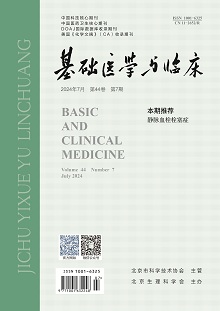Propofol attenuates hypoxia-induced inflammation and apoptosis in rat pheochromocytoma cell line PC12
GU Wei, ZHU Jianping, WU Pinwen
2023, 43(1):
137-143.
doi:10.16352/j.issn.1001-6325.2023.01.0137
 Asbtract
(
114 )
Asbtract
(
114 )
 PDF (2042KB)
(
49
)
References |
Related Articles |
Metrics
PDF (2042KB)
(
49
)
References |
Related Articles |
Metrics
Objective To investigate whether propofol inhibits the expression of miR-141-3p and reduces the molecular mechanism of hypoxia-induced inflammation and apoptosis of pheochromocytoma cell line PC12. Methods PC12 cells were divided into control group, hypoxia group, (5, 10, 20)μmol/L propofol+hypoxia group, anti-miR-con+hypoxia group, anti-miR-141-3p+hypoxia group, miR-con+20 μmol/L propofol+hypoxia group, miR-141-3p+20 μmol/L propofol+hypoxia group. Flow cytometry was used to detect the apoptosis of PC12 cells; Western blot was employed to determine the expression of activated cleaved caspase-3 (cleaved caspase-3) protein, and the kits were implemented to monitor malondialdehyde (MDA) content and superoxide dismutase (SOD) activity; Reactive oxygen species fluorescent probe DCFH-DA method to determine reactive oxygen species (ROS) content; ELISA kits to assay tumor necrosis factor-α (TNF-α), interleukin (IL)-1β, IL-6 content, RT-qPCR to detect the expression of miR-141-3p. Results Compared with the control group, the apoptosis rate, cleaved caspase-3 protein expression level, MDA, ROS, TNF-α, IL-1β, IL-6 content and miR-141-3p expression of PC12 cells in hypoxia group were all increased, while SOD activity weakened (P<0.05). Compared with the hypoxia group, the apoptosis rate, cleaved caspase-3 protein expression level, MDA content, ROS, TNF-α, IL-1β, IL-6 content and miR-141-3p expression of PC12 cells in 5, 10, 20 μmol/L propofol+hypoxia group decreased with the increase of propofol concentration, and SOD activity increased with the increase of propofol concentration (P<0.05). The expression of miR-141-3p, cleaved caspase-3 protein expression, MDA, ROS, TNF-α, IL-1β, IL-6 content and apoptosis rates of PC12 cells in the anti-miR-141-3p+ hypoxia group were lower than those in the anti-miR-con+hypoxia group, and the SOD activity was higher than that in the anti-miR-con+hypoxia group (P<0.05). The miR-141-3p expression, cleaved caspase-3 protein expression level, MDA content, ROS, TNF-α, IL-1β, IL-6 content and cell apoptosis rate of PC12 cells in miR-141-3p+20 μmol/L propofol+hypoxia group were higher than miR-con+20 μmol/L propofol+hypoxia group, while SOD activity was lower than those from miR-con+20 μmol/L propofol+hypoxia group (P<0.05). Conclusions Propofol can alleviate the inflammatory response, oxidative stress and apoptosis of PC12 cells induced by hypoxia by inhibiting the expression of miR-141-3p.


